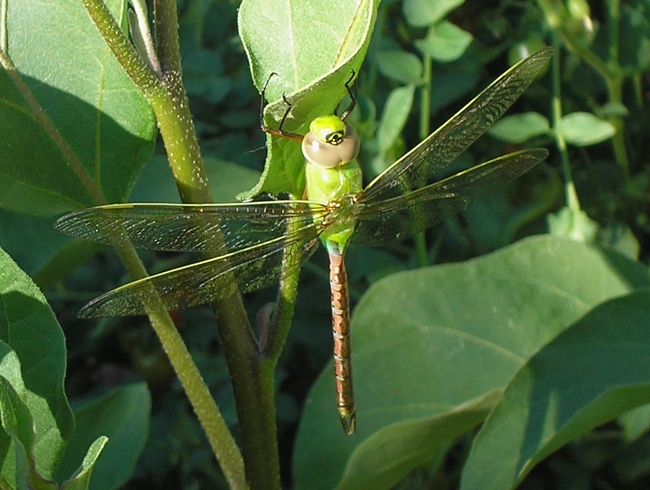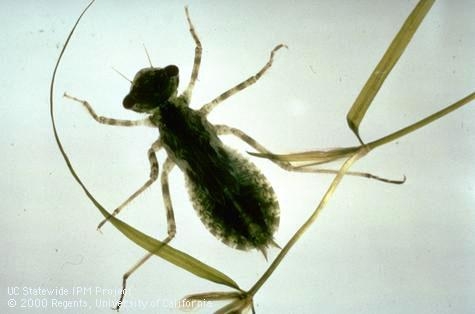How many insects can boast their own international organization? That is the case for dragonflies and damselflies, both members of the order Odonata (meaning “toothed” – the dragonfly has serrated mandibles). The Worldwide Dragonfly Association is dedicated to sharing “research, conservation and public awareness” about these creatures. To that end, they publish two scientific journals and sponsor a biennial International Congress of Odonatology. Their mission? To explore and celebrate what they call an “ancient and beautiful order of insects with amazing behavior.”

“Beautiful” because of their eye-catching jewel-toned iridescence; their large, lacy, double-wing structure; and their long needle-like body and tail.
And “Amazing” because of their fanciful and agile flight patterns, made possible by the unique structure, musculature, placement, and mobility of their wings. In flight, an adult dragonfly can move instantly in any of six different directions: upward, downward, forward, backward, to the left, and to the right. And a seventh: the ability to remain stationary in space, using flight muscles that control each of the four wings separately.
There are subtle differences between dragonflies and damselflies. Dragonflies are generally larger, have heavier bodies, and are stronger fliers. Damselflies have slender bodies and are less powerful fliers. A key difference for identification is that dragonflies hold their wings horizontally both in flight and at rest, while most species of damselfly fold their wings over the abdomen when at rest. This article is primarily concerned with dragonflies.
The nimble, swift, and acrobatic flight of dragonflies, combined with their exceptional eyesight, ensures successful hunting. They have almost 360-degree vision due to their two huge compound eyes, which comprise nearly the entire bulk of the dragonfly head; each compound eye contains about 28,000 single eyes. Dragonflies are voracious insectivores, with an astonishing 95% success rate when capturing prey. They can consume about one fifth of their body weight in prey each day. They'll eat just about any insect, from tiny gnats and midges up to and including damselflies and smaller dragonflies. In fact, if they can't fly, they will die of starvation, because they scoop up prey with their forelimbs while in flight. Because they only eat flying insects, aphids (for example) are safe from their predation, but mosquitos are fair game: one dragonfly can eat from 30 to literally hundreds of mosquitoes daily.
Dragonflies have adapted to life everywhere on earth, inhabiting or visiting every continent except Antarctica, from sea level up to about 12,000 feet, although the number of different species decreases at the highest altitudes. Within the order Odonata, there are eleven dragonfly families, broken down further into 384 genera containing thousands of species. All dragonfly species require aquatic habitat in order to reproduce.
A dragonfly's life begins in fresh water. Mating is complex and multi-step; according to National Geographic the process involves the male self-inseminating, by “curling his body to transfer sperm from his primary genitalia, at the tip of his abdomen, to the secondary genitalia, just below the thorax. When he finds a receptive female, he grasps her behind her head with claspers at the tip of his abdomen, and the two fly off together. When they land, the female curls her abdomen under to meet his secondary genitalia, forming a ‘mating wheel' that can resemble the shape of a heart.” (Sometimes they will mate in the air.)
Immediately after mating and generally in the middle of summer, females lay their eggs by hovering over and dipping their abdomens into a patch of fresh water. These eggs will hatch in about a week. Depending on the species, dragonfly larvae (nymphs) can live in water for up to three years, consuming aquatic insects, mosquito larvae, or even other dragonfly larvae. A dragonfly nymph can go through six to 15 molts before becoming a fully formed adult dragonfly, which emerges in a fairly dramatic fashion: once it crawls out of the water, its exoskeleton breaks open to release the abdomen, which was nestled in like a telescope. Next, its four wings come out, and they dry and harden over the next several hours to days.

Sadly, some species of the beautiful, mesmerizing adults live only about a month, while others live up to a year, delighting us by zooming around our gardens, posing momentarily on garden stakes or plant stems, and hunting for their next meal.
Dragonflies have captured the imagination of humans for thousands of years, serving different roles depending on the culture. For some indigenous peoples of the American southwest, dragonflies had special status as medicine animals, with the power to effect transformation. For the Navajo, they symbolized pure water. In China dragonflies are seen as agents of change, so in feng shui practice the placement of a dragonfly image is thought to bring new insights and changes for the better. In Japan, dragonflies represent rebirth, courage, strength, and happiness.
In Europe, though, dragonflies have played a more sinister role. Some English vernacular names, such as "horse-stinger", "devil's darning needle", and "ear cutter", associate them with evil or injury. The north American colonists brought these beliefs with them, carrying across the ocean the superstition that dragonflies could stitch shut the mouths, and sometimes the eyes and ears, of lying children, scolding women, and cursing men. This belief is reflected in the common species name of “darner” (as in a needle used to darn socks).
Common names of dragonfly species found in northern California are excellent indications of their morphology and of their hunting and flying prowess. A list provided by the San Francisco Bay Wildlife Information website includes the following: Common Green Darner; Blue-eyed Darner; California Darner; Variegated Meadowhawk; Cardinal Meadowhawk; Western Pondhawk; Blue Dasher; Common Whitetail; Widow Skimmer; Eight-spotted Skimmer; Flame Skimmer; Wandering Glider; Spot-winged Glider; and Black Saddlebags.
These and many other dragonfly species will be featured at the next Worldwide Dragonfly Association's International Congress on Odonatology, being held this year on the Mediterranean island of Cyprus, June 25 through 30, 2023.
JOB OPPORTUNITY: UC Cooperative Extension has an opening for an individual who can provide administrative and program oversight to the Master Gardener Program, plus technical and educational training to support the creation and maintenance of gardening programs with UC CalFresh Nutrition Education Program clientele in Butte County. For more information and to apply for the Garden Education Coordinator position visit Jobs - Division of Agriculture and Natural Resources (ucanr.edu).
UC Master Gardeners of Butte County are part of the University of California Cooperative Extension (UCCE) system. To learn more about us and our upcoming events, and for help with gardening in our area, visit our website. If you have a gardening question or problem, email the Hotline at mgbutte@ucanr.edu or leave a phone message on our Hotline at (530) 538-7201. To speak to a Master Gardener about a gardening issue, or to drop by the MG office during Hotline hours, see the most current information on our Ask Us section of our website.